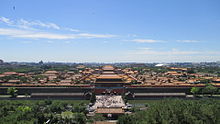
The Forbidden City was first built in the early-15th century as the palace of the Ming emperors of China. It is located in the centre of Beijing, China, and was the Chinese imperial palace from the early-Ming dynasty in 1420 to the end of the Qing dynasty in 1912, continuing to be home of the last emperor, Puyi, until 1924, since then it has been a museum.
Built from 1406 to 1420, the palace complex has undergone many changes.[1] After serving as the imperial palace for some five hundred years, the Forbidden City became a museum, the Palace Museum, in 1925. In 1987, it was declared a World Heritage Site by UNESCO.[2]
- ^ "故宫到底有多少间房 (How many rooms in the Forbidden City)" (in Chinese). Singtao Net. 2006-09-27. Archived from the original on 2007-07-18. Retrieved 2007-07-05.
- ^ "UNESCO World Heritage List: Imperial Palaces of the Ming and Qing Dynasties in Beijing and Shenyang". UNESCO. Retrieved 2007-05-04.
